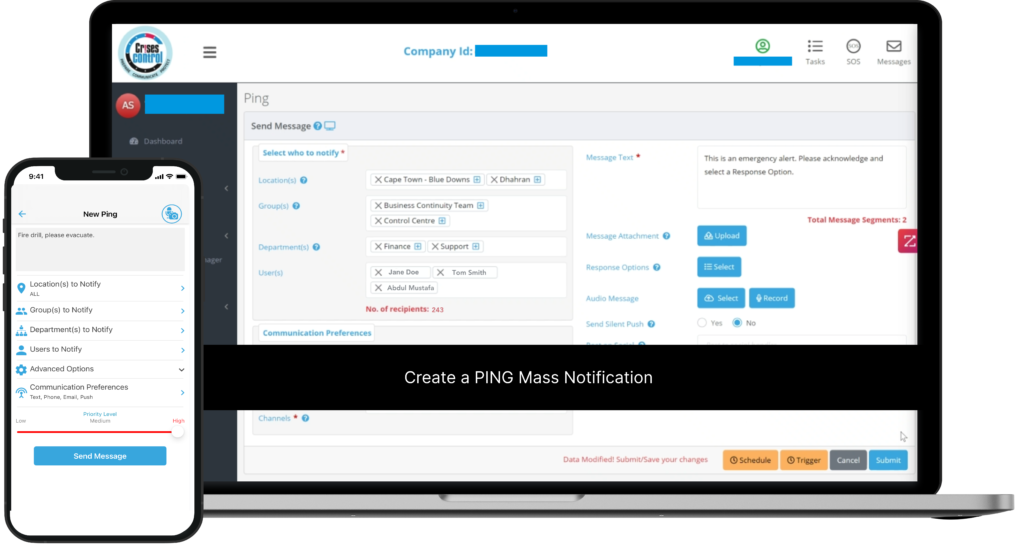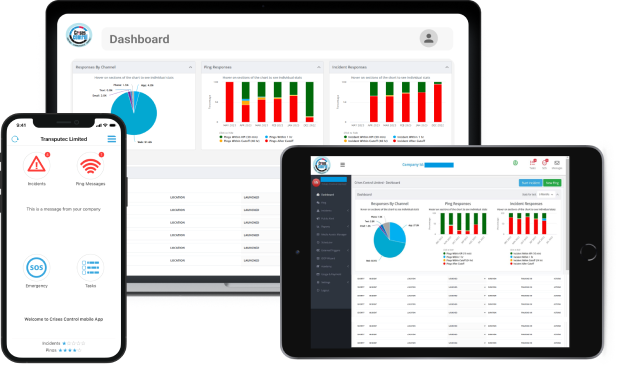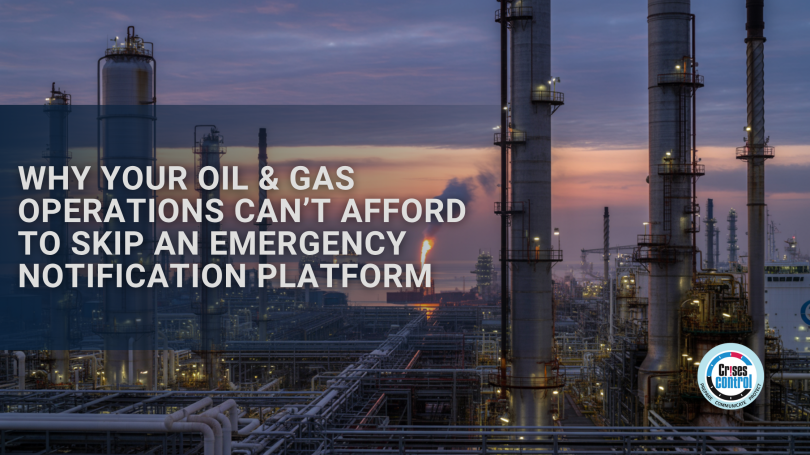Written by Anneri Fourie | Crises Control Executive
In the oil and gas industry, time is always of the essence. Whether your operations are in the depths of the North Sea, the deserts of the Middle East, or remote offshore platforms, emergencies are inevitable. What sets successful companies apart in these moments isn’t just having an emergency response plan, but ensuring that real-time communication is at the core of that plan.
When an emergency strikes, the clock starts ticking, and every second lost means more risk, both to personnel and to the environment. In an industry where the consequences of miscommunication can be catastrophic, having an Emergency Notification Platform is no longer optional; it’s a necessity.
In this blog, we’ll explore why real-time communication is crucial for oil and gas emergency response, and how the right emergency notification platform can help reduce risks, improve safety, and ensure faster, more efficient responses. We’ll also explain how Crises Control offers a tailored solution for high-risk energy environments.
The Problem: Delayed Communication in High-Risk Oil & Gas Operations
Oil and gas operations often happen in some of the most remote and dangerous environments. From offshore drilling platforms to isolated refineries, getting timely updates and making decisions in the heat of an emergency is a serious challenge. Traditional methods of communication, such as radio or manual reporting, can be unreliable and too slow. In a crisis, the failure to quickly reach the right person with the right information can result in severe consequences, including:
- Increased risk to personnel: Without clear communication, emergency protocols can be misinterpreted or missed entirely, jeopardising the safety of workers.
- Environmental damage: A delayed response to gas leaks, spills, or fires can lead to significant harm to the environment, costing millions in cleanup and fines.
- Financial losses: The longer it takes to address a crisis, the greater the potential for costly downtime and damage to equipment or infrastructure.
The solution? Real-time communication enabled by a robust emergency notification platform that ensures everyone, from field teams to senior management, is always on the same page, right when it matters most.
Why Real-Time Communication Matters in Oil & Gas Emergency Response
In the oil and gas industry, everything is time-sensitive. When an emergency hits, whether it’s a gas leak, fire, explosion, or oil spill, the ability to act fast can mean the difference between controlling the situation or letting it spiral out of control. Here’s why real-time communication is so vital:
1. Faster Decision-Making
Every emergency response relies on speed. The longer it takes to make decisions, the higher the risk. Real-time communication ensures that key decision-makers get the right information without delay. Whether it’s a senior manager in the control room or an operator on a remote platform, knowing exactly what’s happening and where allows teams to make informed, swift decisions that can mitigate risks and reduce the damage caused by the crisis.
2. Improved Coordination
Oil and gas operations are rarely localised to one place; they often span vast areas. A single incident can affect multiple teams across different locations. Without seamless communication, it’s easy for critical updates to be missed, or for different teams to work at cross purposes. Real-time communication platforms ensure everyone gets the same message at the same time, allowing teams to coordinate effectively and avoid confusion.
3. Enhanced Safety of Personnel
The safety of your workforce is non-negotiable. In high-risk environments like oil and gas, delays in alerting teams about an ongoing emergency can result in injuries or fatalities. A real-time system that notifies personnel immediately, and gives them clear instructions, ensures a fast, organised response to evacuate personnel or take other safety measures.
How an Emergency Notification Platform Works in High-Risk Environments
So, how exactly does an Emergency Notification Platform help streamline communication during emergencies? These systems are designed to ensure that the right people get the right information, at the right time, through the most effective channels. Let’s break it down.
Multi-Channel Communication
Emergencies can affect multiple locations and teams. The best emergency notification platforms allow you to reach everyone, whether they’re on-site, in the office, or working remotely, across multiple channels. Whether it’s via SMS, email, voice calls, or mobile apps, having diverse communication options means that no one misses a critical update, regardless of where they are or what device they’re using.
Geolocation and Targeted Alerts
In an emergency, it’s important to know not just who to alert, but where they are. An effective Emergency Notification Platform integrates geolocation, so notifications can be sent specifically to those who are in harm’s way. If a fire breaks out at one part of your facility, you can quickly notify only the teams near that area, avoiding unnecessary panic or confusion.
Automated Alerts and Escalation
Emergencies are fast-moving and require rapid responses. Manual intervention can introduce delays, and in some situations, time is something you can’t afford to lose. A great emergency notification platform automates alerts based on predefined triggers. This means that when a situation escalates, the system automatically notifies the appropriate people without waiting for human input. It can also escalate issues to senior managers if necessary, ensuring the right response at the right level.
Two-Way Communication
While sending alerts is crucial, being able to get feedback is just as important. Two-way communication allows those on the front lines, whether they’re at a drilling site or an offshore rig, to send updates, ask for assistance, or report progress on emergency procedures. This flow of information ensures that decision-makers are always in the loop and can adapt their response as needed.
Crises Control: A Tailored Solution for Oil & Gas Emergency Response
At Crises Control, we understand that every second counts during an emergency, especially in high-risk industries like oil and gas. Our Emergency Notification Platform has been designed specifically for industries where every decision is critical, and the consequences of failure can be catastrophic.
Real-Time, Multi-Channel Alerts
Our platform ensures your emergency messages are sent across multiple channels, including SMS, email, voice calls, and mobile push notifications, so no one is left behind. Whether your teams are in the field, at a remote station, or in the control room, Crises Control ensures they’re all immediately informed.
Geolocation for Targeted Alerts
With our geolocation feature, emergency alerts are tailored to specific teams in affected areas, reducing confusion and ensuring faster, more focused responses. This is essential for minimising risk, especially in large, complex operations.
Automated Alerts and Escalation
Crises Control offers automated alerting and escalation, making sure that critical actions are taken without delay. If an emergency grows worse, our platform will automatically escalate the issue to senior staff, triggering predefined response procedures.
Two-Way Communication for Real-Time Updates
In an emergency, real-time information flow is essential. Our two-way communication feature allows field teams to send back updates, request assistance, or confirm actions taken. This ensures that the crisis management team always has the most accurate, up-to-date information.
Interested in our Ping Emergency Notification Platform?
Efficiently alert everyone in seconds at scale with our Emergency Notification Platform – PING, get the message out fast and ensure rapid response and recovery.

Conclusion: Streamline Your Emergency Response with Crises Control
The oil and gas industry operates in a high-risk environment where every second counts. Real-time communication through a robust Emergency Notification Platform can make all the difference in ensuring a fast, coordinated, and effective response during emergencies.
Crises Control’s platform offers everything you need to streamline communication, reduce risks, and protect both your personnel and assets. Don’t wait for the next crisis to prove how critical real-time communication is, contact Crises Control today for a free demo and see how our platform can transform your emergency response process.
Request a FREE Demo

